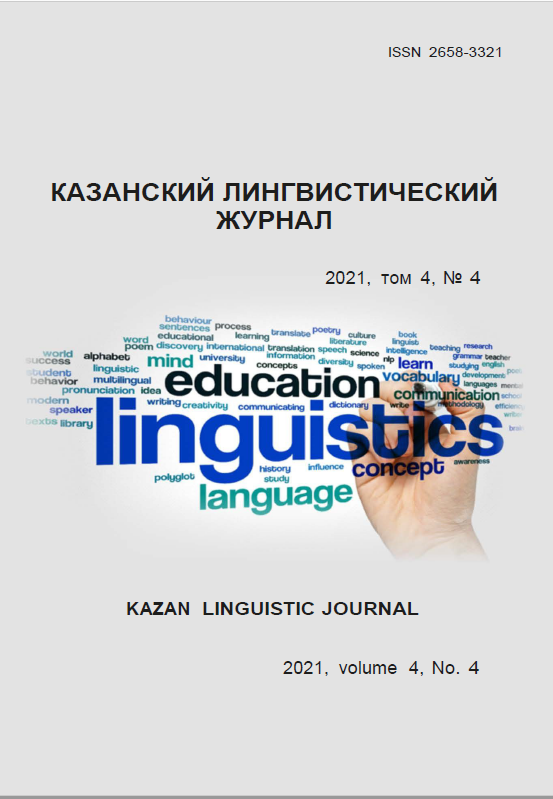Психолингвистическое восприятие аудиовизуальных материалов
https://doi.org/10.26907/2658-3321.2021.4.4.524-536
Ключевые слова:
психолингвистический эксперимент, восприятие информации, мультимодальный текст, аудиовизуальный перевод, внимание реципиентовАннотация
Аудиовизуальные материалы появились в середине 50-ых годов XX века, и с тех пор их популярность растет с каждым днем. В России аудиовизуальный перевод (АВП) таких материалов получил активное развитие лишь в 90-ых годах прошлого столетия. Особенной чертой такого вида перевода является его одновременная направленность на аудиальный и визуальный каналы восприятия реципиентов. На сегодняшний день проблемы понимания и восприятия аудиовизуальных материалов, а также вопросы наличия или отсутствия взаимосвязи между психологическими особенностями индивидов-реципиентов и тем, как ими воспринимается перевод таких типов материалов, остаются малоизученными. В статье приведен обзор литературных источников, посвященных данной проблеме. В частности, рассмотрены современные научные работы, направленные на изучение влияния психологических особенностей определенных групп реципиентов на уровень восприятия мультимодальных текстов – фильмов и сериалов, описаны характеристики АВП такого рода материалов с языка оригинала на родной язык аудитории. В статье также представлены результаты ряда психолингвистических экспериментальных исследований, посвященных проблемам понимания и уровням восприятия мультимодальных текстов. В заключении представлены практические рекомендации по проведению различных типов психолингвистических экспериментов.
Библиографические ссылки
References
Cintas J.D., Szarkowska A. Introduction: Experimental research in audiovisual translation – Cognition, reception, production. The Journal of Specialised Translation. 2020; 33: 3–16.
Kruger J.-L., Soto-Sanfiel., M.T., Doherty, S., Ibrahim, R. Towards a cognitive audiovisual translatology: Subtitles and embodied cognition. John Benjamins Publishing Company. 2016; 171–194.
Orero Pilar, et al. Conducting experimental research in audiovisual translation (AVT): A position paper. The Journal of Specialised Translation. 2018; 30: 105–126.
Romero-Fresco P. The reception of subtitles for the deaf and hard of hearing in Europe: UK, Spain, Italy, Poland, Denmark, France and Germany. Bern: Peter Lang; 2015
Jensema C. Viewer reaction to different captioned television speeds. Institute for Disabilities Research and Training; 1997. Available from: https://www.dcmp.org/caai/nadh30.pdf [accessed: 08.04. 2021].
Szarkowska A., Gerber-Moro´n O. Viewers can keep up with fast subtitles: Evidence from eye movements. PLoS ONE. 2018; 13(6): e0199331. Available from: https://doi.org/10.1371/journal.pone.0199331 [accessed: 08.04. 2021].
Di Giovanni E. (Reception studies and audiovisual translation: Eye tracking research at the service of training in subtitling. Iconesoft Edizioni; 2019.
Callum W. A cognitive perspective on equivalent effect: using eye tracking to measure equivalence in source text and target text cognitive effects on readers. Perspectives. 2019; 27(1): 124–143.
Ragni V. More than meets the eye: an eye-tracking study of the effects of translation on the processing and memorisation of reversed subtitles. The Journal of Specialised Translation. 2020; 33: 99–128.
Green M., Brock T., Kaufman G. Understanding media enjoyment: the role of transportation into narrative worlds. Communication theory. 2004; 14(4): 311–327.
De Los Reyes Lozano J. Straight from the horse’s mouth: children’s reception of dubbed animated films in Spain. Jostrans. The Journal of Specialised Translation. 2020; 33: 233–258.
Kruger J.-L. Psycholinguistics and audiovisual translation. International Journal of Translation Studies. 2016; 28.2: 276–287.
García A. Psycholinguistic explorations of lexical translation equivalents: Thirty years of research and their implications for cognitive translatology. Translation Spaces. 2015; (4): 9–28.
Orrego-Carmona D., Łukasz D., Szarkowska A. Using translation process research to explore the creation of subtitles: an eye-tracking study comparing professional and trainee subtitlers. The Journal of Specialised Translation. 2018; (30): 150–180.
Panasiuk I. The free associative experiment as a psycholinguistic investigation method of the trans lation process: A theoretical insight. Germanica Wratislaviensia. 2020; (145): 179–198.
Pérez-González L. Audiovisual translation: Theories, methods and issues. London: Routledge; 356.
Szarkowska A., et al. The effects of text editing and subtitle presentation rate on the comprehension and reading patterns of interlingual and intralingual subtitles among deaf, hard of hearing and hearing viewers. Across Languages and Cultures. 2016; 17.2: 183–204.
Kruger J.-L. Eye tracking in audiovisual translation research from: The Routledge Handbook of Audiovisual Translation. Routledge; 2018. Available from: https://www.routledgehandbooks.com/doi/10.4324/9781315717166-22 [accessed: 08.04. 2021].






